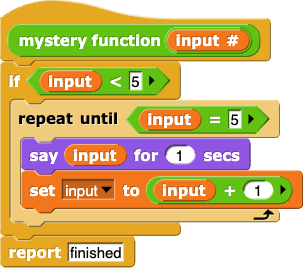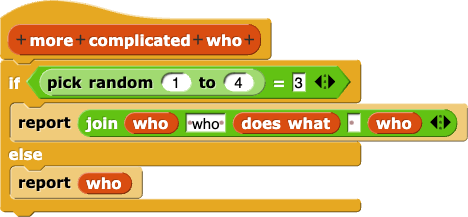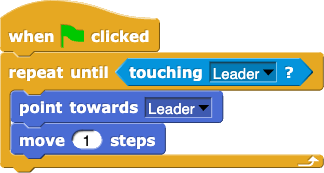Checking the Player's Guess
People are getting confused by the On the Exam box and are trying to build the code in there. --MF, 8/1/23
On this page, you'll continue to develop your number guessing game to accept player guesses until the player guesses correctly.
You'll want the computer to ask players to guess again and again until they guess correctly. To do that, you will use the  block.
block. Repeat until is a loop (just like repeat, forever, and for) but also a conditional (like if and if else). It repeats until a certain condition is met. For this program, the code should repeat until the player's answer equals the secret number.

- Use
repeat until to ask the player ( ) to guess the secret number until their
) to guess the secret number until their  equals the secret number.
equals the secret number.
- Drag the secret number variable out of the
script variables block to use it.
- The
ask and answer blocks go together. If you use ask to ask a question, the user's answer will be reported by answer.
The code

would be written as
DISPLAY("Why did the chicken cross the road?")
userResponse ← INPUT() or

.
AAP-3.A.8, AAP-3.A.9
Notice that the procedure
INPUT()
accepts the value from the user and returns that input value, which is then assigned to the variable
userResponse
with the
←
syntax. In Snap
!, this is just like how
answer accepts a value from the user and reports it, and that report is what the computer
sets the variable
user response to.
AAP-2.B
- After the player guesses the secret number, make the computer congratulate the player.
- Test and debug. Take turns playing the game, and fix any problems with the code before moving on.
Repeat until makes its decision based on the output of a hexagonal predicate block.
:
Predicate and
Boolean value
 Why is Boolean capitalized?
Why is Boolean capitalized?
The word Boolean is capitalized because it's named after a person, George Boole, who invented the branch of mathematics dealing with Boolean operations (such as and, or, and not).
A predicate is a hexagon-shaped reporter that asks a true/false question such as these examples:


AAP-2.E.1
Predicates report a Boolean value (either  or
or  ).
).
Predicates fit into a hexagonal input slots of conditionals, such as in  and
and  . Predicates help conditionals decide when to do something.
. Predicates help conditionals decide when to do something.
:
Conditions and
Conditionals
The if and if-else blocks are called conditionals because they control the code based on a true-or-false condition.
redo pic in yellowbox with plain prototype labels --MF, 2/6/25
-
We really shouldn't be encouraging students to mutate a block's inputs. There are really two issues here; one is with the x=x+1 style of programming altogether, and the second is that formal parameters specifically shouldn't generally be mutated; it's better to make a script variable that's initialized to the input value. (If we change this, we need to update the Guided Notes.) --MF, 6/26/21 with BH

Which inputs to
mystery function will report "finished"?
Any integer
Correct! No matter what the input number is (as long as it's an integer), the report block will eventually run. (This doesn't necessarily happen in every procedure, but here it will.)
Only integers greater than or equal to 5
Write out some examples of what happens when the input is less than 5. For example, if the input is 3, the sprite will say 3, the input will be changed to 4, the sprite will say 4, the input will be changed to 5, the repeat until loop will stop, and the function will report "finished."
Only integers less than 5
The report command isn't inside the if.
Only 5
The repeat until block checks the value of input every time through the loop, not just its initial value.
-
 What will the sprite say
What will the sprite say if you run the same function with the input 1?
It does say 4 at the end, but it says other things before that.
How does repeat until work?
Correct! The repeat until block runs the code in its script slot until input = 5, then the computer skips down to the next command, report (finished), without the sprite ever saying 5.
The repeat until block tests the value of input before running the code in its script slot.
The feedback is not finished because I realized that BH might object to changing the value of an input variable... --MF, 3/1/19
-
 What will happen
What will happen if you run the same function with the input 9?
The sprite will say 9, and the block will report "finished."
What does the if block do when input is 9?
The sprite will say 9, 8, 7, 6, and the block will report "finished."
What does the set instruction do to the value of input?
The sprite will say 9, 10, 11, 12, 13, … and keep counting, and the block will never report "finished."
When input is 9, will the code inside the if command run?
The sprite will say nothing, and the block will report "finished."
Correct! The code inside the if command will not run.
The feedback is not finished because I realized that BH might object to changing the value of an input variable... --MF, 3/1/19
- When the computer congratulates the player for guessing correctly, have the computer say the number. For example, it might say, "You guessed it! My secret number was 7."
Use join to merge the text "You guessed it! My secret number was" with the value of the secret number variable.
 block.
block.  ) to guess the secret number until their
) to guess the secret number until their  equals the secret number.
equals the secret number.
 would be written as
would be written as
 .
.


 or
or  ).
). and
and 

 Which inputs to
Which inputs to 


